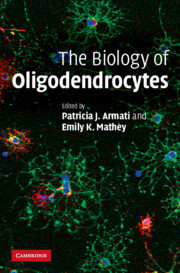Book contents
- Frontmatter
- Contents
- Preface
- Contributors
- 1 CNS oligarchs; the rise of the oligodendrocyte in a neuron-centric culture
- 2 Comparative biology of Schwann cells and oligodendrocytes
- 3 Control of oligodendrocyte development and myelination in the vertebrate CNS
- 4 Molecular organization of the oligodendrocyte and myelin
- 5 The genetics of oligodendrocytes
- 6 Immunobiology of the oligodendrocyte
- 7 Oligodendrocytes and disease: repair, remyelination and stem cells
- 8 Glial progenitor cells and the dynamics of the oligodendrocyte and its myelin in the aged and injured CNS
- 9 Oligodendroglial pathology in multiple sclerosis
- 10 Glutamate receptors, transporters and periventricular leukomalacia
- References
- Index
- Plate section
6 - Immunobiology of the oligodendrocyte
Published online by Cambridge University Press: 05 August 2012
- Frontmatter
- Contents
- Preface
- Contributors
- 1 CNS oligarchs; the rise of the oligodendrocyte in a neuron-centric culture
- 2 Comparative biology of Schwann cells and oligodendrocytes
- 3 Control of oligodendrocyte development and myelination in the vertebrate CNS
- 4 Molecular organization of the oligodendrocyte and myelin
- 5 The genetics of oligodendrocytes
- 6 Immunobiology of the oligodendrocyte
- 7 Oligodendrocytes and disease: repair, remyelination and stem cells
- 8 Glial progenitor cells and the dynamics of the oligodendrocyte and its myelin in the aged and injured CNS
- 9 Oligodendroglial pathology in multiple sclerosis
- 10 Glutamate receptors, transporters and periventricular leukomalacia
- References
- Index
- Plate section
Summary
INTRODUCTION
Oligodendrocytes, as the myelin-producing cells of the central nervous system (CNS), are exactly what their Greek-derived name “oligodendroglia” suggests: they, alongside astrocytes, the non-neural microglia and ependymal cells, have been characterized as the “glue” that holds together the intricate apparatus of our brain. The fact that oligodendrocyte and astrocyte cells outnumber neurons by ten to one illustrates their importance, which is particularly highlighted by the oligodendrocyte's role in accelerating transmission of axonal action potentials. On the other hand, oligodendrocytes are involved in a number of serious diseases of viral, metabolic and immunological origin. This chapter tries to shed light on the immunobiological properties of oligodendroglial cells in the healthy and diseased CNS. We will begin with an overview of diseases featuring oligodendrocyte/immune system interactions and will then, in the second part, focus on the molecular repertoire that allows these cells to interact directly or indirectly with immune cells. Subsequently, we will discuss oligodendrocytes as antigen-presenting cells and finally we will present data on direct oligodendroglial/immune cell interactions.
IMMUNE-MEDIATED DISEASES AFFECTING OLIGODENDROCYTES
Multiple sclerosis
Multiple sclerosis (MS), which was first described by the French neurologist Jean-Martin Charcot in 1868 (Charcot, 1868), is a chronic inflammatory disease of the CNS of unknown etiology (Hemmer et al., 2006). Although an ideal system for the classification of different MS stages does not yet exist (Van der Valk and De Groot, 2000) there is broad consensus that loss of myelin due to oligodendrocyte damage or death together with axonal degeneration leading to reactive glial scar formation are the key hallmarks of this disease (Trapp and Nave, 2008).
- Type
- Chapter
- Information
- The Biology of Oligodendrocytes , pp. 115 - 136Publisher: Cambridge University PressPrint publication year: 2010



